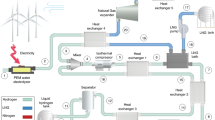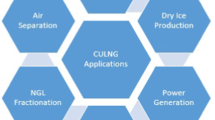Abstract
This paper presents an optimization model via genetic algorithm (GA) to maximize the power generation potential of a liquefied natural gas (LNG) cold energy recovery plant. LNG releases a large amount of cold energy during vaporization prior to transport for service, and this cold energy can be effectively utilized to generate power using a heat engine. We performed a thermodynamic analysis for a power generation system combining the organic rankine cycle (ORC) driven by LNG exergy and the direct expansion cycle. Both LNG and the working fluid in the combined ORC are light hydrocarbon mixtures, and their physical properties were estimated using the Peng-Robinson equation. We conducted a thorough investigation of the effects that the working fluid composition brought about on the thermal efficiency of the heat engine through an analysis using Aspen HYSYS interfaced with a GA-based Matlab solver. The results showed that optimization of the working fluid composition led to an increase of 58.4% in the performance of the combined ORC in terms of the net work.
Similar content being viewed by others
References
J.-D. Kim, The technology trend of power generation plant utilizing LNG cold energy, KIST, Seoul (2003).
http://www.eng.usfedu/∼hchen4/Organic%20Rankine%20Cycle.htm.
J. Nouman, Comparative studies and analyses of working fluids for Organic Rankine cycle, Master of Science Thesis, KTH School of Industrial Engineering and Management, Stockholm (2012).
G. Shu, Y. Gao, H. Tian, H. Wei and H. Liang, Energy, 74, 428 (2014).
P. Garg, P. Kumar, K. Srinivasan and P. Dutta, Appl. Therm. Eng., 51, 292 (2013).
J. G. Andreasen, U. Larsen, T. Knudsen, L. Pierobon and F. Haglind, Energy, 73, 204 (2014).
M. Chys, V. D. Broek, B. Vanslambrouck and D. Paepe, Energy, 44, 623 (2012).
S. Lecompte, B. Ameel, D. Ziviani, V. D. Broek and D. Paepe, Energy Convers. Manage., 85, 727 (2014).
L. Zhao and J. Bao, Energy Convers. Manage., 83, 203 (2014).
Y. Feng, T. C. Hung, K. Greg, Y. Zhang, B. Li and J. Yang, Energy Convers. Manage., 106, 859 (2015).
I. H. Choi, S. I. Lee, Y. T. Seo and D. J. Chang, Energy, 61, 179 (2013).
K. H. Kim, J. M. Ha and K. C. Kim, Trans. Korean Hydrogen New Energy Soc., 25, 200 (2014).
Y. Liu and K. Guo, Energy, 36, 2828 (2011).
H. Sun, H. Zhu, F. Liu and H. Ding, Energy, 70, 314 (2014).
A. Alabdulkarem, A. Mortazavi, Y. Hwang, R. Radermacher and P. Rogers, Appl. Therm. Eng., 31, 109 (2011).
A. Baghernejad and M. Yaghoubi, Energy Convers. Manage., 52, 2193 (2011).
M. Ghazi, P. Ahmadi, A. F. Sotoodeh and A. Taherkhani, Energy Convers. Manage., 58, 149 (2012).
B. E. García-Flores, J. Águila-Hernández, F. García-Sánchez and R. P. Stateva, In handbook of liquefied natural gas, S. Mokhatab, J. Y. Mak, J. V. Valappil and D. A. Wood Eds., Gulf Professional Publishing, Elsevier, New York (2014).
D. Y. Peng and D. B. Robinson, Ind. Eng. Chem. Fundam., 15, 59 (1976).
S. A. R. Tabaei, Comparison of cubic equations of state in predicting behavior of mixtures of varying complexity, New Mexico Institute of Mining and Technology, Master’s Dissertation (1988).
M. Kariznovi, H. Nourozieh and J. Abedi, Chem. Eng. Data, 57, 2535 (2012).
E. B. Cho, M. Jeong, I. J. Hwang and C. H. Kang, Trans. Korean Soc. Mech. Eng. C, 3, 55 (2015).
F. J. Varela and P. Bourgine, Toward a practice of autonomous systems, The MIT Press, London (1994).
R. Malhotra, N. Singh and Y. Singh, Comput. Information Sci., 4, 2 (2011).
http://kr.mathworks.com/help/gads/how-the-genetic-algorithm-works.
Acknowledgements
This work was supported by a grant (19IFIP-B089065-05) from the Industrial Facilities & Infrastructure Research Program (IFIP) funded by Ministry of Land, Infrastructure and Transport of the Korean government.
Author information
Authors and Affiliations
Corresponding author
Rights and permissions
About this article
Cite this article
Jeong, M., Cho, EB., Byun, HS. et al. Maximization of the power production in LNG cold energy recovery plant via genetic algorithm. Korean J. Chem. Eng. 38, 380–385 (2021). https://doi.org/10.1007/s11814-020-0662-7
Received:
Revised:
Accepted:
Published:
Issue Date:
DOI: https://doi.org/10.1007/s11814-020-0662-7




